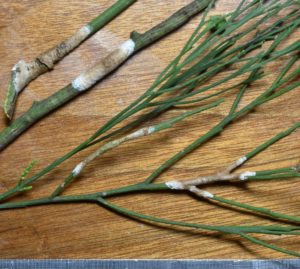Tom May (Royal Botanic Gardens Victoria)

In May 2019, Fungimap held events in East Gippsland as part of the ‘Putting the Victorian fungi on the map’ project supported by the Victorian governnment. One of the events was a trip to Fairy Dell, organised by the Bairnsdale and District Field Naturalist Club. At Fairy Dell, a Junior Field Nat parent Daniel helped spot a rarely documented fungus in the genus Septobasidium.
The as-yet unidentified species of Septobasidium forms thin patches on living branchlets, looking from a distance rather like a patch of bird dropping. The surface is pale brown and smooth, like kid leather, with a thinner, whitish, silky layer at the margins. There have been few observations of this type of Septobasidum from Victoria, one from far eastern Victoria and one from around the Strzelecki Ranges, both Cherry Ballart tree (Exocarpos cupressiformis).
Tom was excited to see the fungus in the field for the first time, at Fairy Dell, again on Cherry Ballart. All species of Septobasidium form a symbiotic relationship with scale insects. The fungus forms chambers, where the immature stages of the scale insects develop (while sucking sap from the plant below), protected from parasites such as wasps. However, the fungus also parasitises some of the immature scale insects, growing inside the insects, and preventing them from maturing. If you peel back the felty layer, you can see the tiny immature scale insects.

Another species of Septobasidium in Victoria is more commonly observed: Septobasidium clelandii, which is very different in appearance, forming black, spiky sporing bodies that emerge from galls on the branches of Leptospermum (Tea Trees). To read more about the common and named species of Septobasidium read this post.


